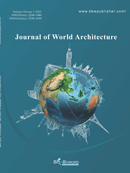Numerical Simulation Research on Response Characteristics of Grouting Defects of Ground Penetrating Radar for Detection of Grouting Quality behind Tunnel Wall
Abstract
The effect of grouting behind tunnel wall directly affects the surrounding ground settlement and the stability of tunnel structure, so the grouting quality detection is very necessary. As an efficient and convenient shallow geophysical exploration method, ground-penetrating radar can meet the high-resolution and non-destructive requirements of grouting quality detection behind the tunnel wall, so it is widely used in engineering in recent years. Most of the existing studies have obvious regional pertinence and special geological conditions, and there are few universal studies on the characteristics of the ground penetrating radar reflection image of the grouting defect behind the tunnel wall. In view of this, this paper uses the finite difference time domain method to simulate several grouting defects behind the wall, such as voids, water-bearing anomaly, cracks, and other grouting defects. The simulation results show that the reflection image of the direct wave is characterized by a white band with strong amplitude; the interface between primary support and second lining, primary support, and surrounding rock is also banded; the circular cavity and water anomaly characteristics are all hyperbolic, the difference is that the phase of the lower part of the radar image of the cavity anomaly is 0, and there are only hyperbolic tails on both sides, and the water-bearing anomaly also has obvious hyperbolic characteristics at each interface; the reflected wave characteristics of the rectangular crack are striped and watery and the reflected wave characteristic of rectangular cracks is striped, and the abnormal range of water-bearing cracks on the radar image is larger than that of air. The research results can provide an effective theoretical reference for the engineering application of ground penetrating radar detection of grouting defects behind the tunnel wall.
References
Yang B, 2016, Research on Establishing All-round and Three-dimensional Quality Protection of Oil Pipeline. China Petroleum and Chemical Standard and Quality, 36(12),29-29+40.
Xiao P, Liu C, Sun K, 2019, Study on Grouting Treatment of Water Inrush and Mud Inrush Disaster in Expressway Tunnel. Transpo World, (9): 103-104.
Ding Z, 2004, Research on Laws of Surface Lift and Subsidence during Grouting at the Back of Tunnel Wall in the Shanghai Subway. Coal science research institute.
Lin C, Wang X, Li Y, et al., 2020, Forward Modelling and GPR Imaging in Leakage Detection and Grouting Evaluation in Tunnel Lining. KSCE Journal of Civil Engineering, 24(1): 278-294.
Xie X, Zhai J, Zhou B, 2021, Back-Fill Grouting Quality Evaluation of the Shield Tunnel Using Ground Penetrating Radar with Bi-Frequency Back Projection Method. Automation in Construction, 121: 103435.
Bai M, Chen Y, Wang C, et al., 2018, Radar Spectral Analysis and Evaluation of the Effect of Grouting Treatment in Karst Caves and Soil Caves. Environmental Earth Sciences, 77(24): 1-12.
Du J, Huang H, Xie X, 2007, Simulation of GPR Detecting of Grouting Materials Behind Shield Tunnel Segments. Chinese Journal of Geotechnical Engineering, 29(2): 243-248.
Sun Z, et al., 2013, The Tunnel Detection Forward Numeral Simulation and Measured Data Analysis based on GPRMax. Chinese Journal of Engineering Geophysics, 10(5): 730-735.
Du J, Huang H, Xie X, 2005, Research on the Simulation Examination about GPR Detection of Grounting Material Shield Tunnel Segment. Chinese Journal of Underground Space and Engineering, (6): 817-820.
Zeng C, et al., 2005, GPR Forward Simulation for Shield Tunnel Conditions Based on theConsistent Information Removal Method. Moden Tunnelling Technology, 52(4): 173-178.
Zeng ZF. et al., 2006, Principle and Application of Ground Penetrating Radar. Beijing: Science Press.
Bai B, Zhou J, 2001, Development and Application Status of Ground Penetrating Radar Testing Technology. Chinese Journal of Rock Mechanics and Engineering, (4): 527-531.
Guo S, et al., 2019, Ground Penetrating Radar Multi-Profile Integrated Interpretation Method and Application. Progress in Geophysics, 34(5): 2022-2029.
Xiao D, Li W, Guo P, 2015, The Tunnel Lining Detection Numerical Simulation based on GPRMax and its Application. Geophysical and Geochemical Exploation, 39(4): 855-859.
Xu H, Liu J, Fan C, et al., 2013, Forward Modeling of Tunnel Lining Diseases Ground Penetrating Radar Wave Field and Characteristics Analysis. Journal of Central South University (Science and Technology), 44(11): 4581-4587.
Wang F, Xiao G, Yin J, 2003, Application of Ground Probing Radar to Detection of Lining Concrete Quality. Rock and Soil Mechanics, 2003(S1): 183-185.
Li J, Guo C, Wang F, et al., 2007, The Summary of the Surface Ground Penetrating Radar Applied in Subsurface Investigation. Progress in Geophysics, (2): 629-637.
Feng D, Dai Q, He J, et al., 2006, Finite Difference Time Domain Method of GPR Forward Simulation (English). Progress in Geophysics, (2): 630-636.
Yee KS, 1966, Numerical Solution of Initial Boundary Value Problems Involving Maxwell’s Equations in Isotropic Media. IEEE Transactions on Antennas & Propagation, 14(3): 302-307.
Lv N, 2020, Analysis of FDTD based Ground Penetrating Radar Forward Simulation. Journal of Luoyang Institute of Science and Technology (Natural Science Edition), 30(4): 63-68, 74.
Li Z, Pu D, Zhong M, 2019, Contrastive Study on Waveform Characteristics between Ground Penetrating Radar Simulation and Detection Example in Karst Structure of Highway Tunnel. Technology of Highway and Transport, 35(2): 110-117.

